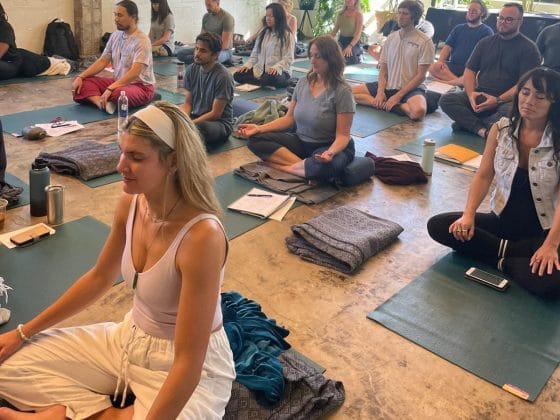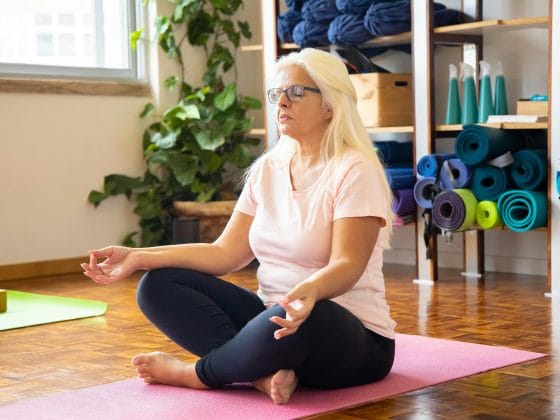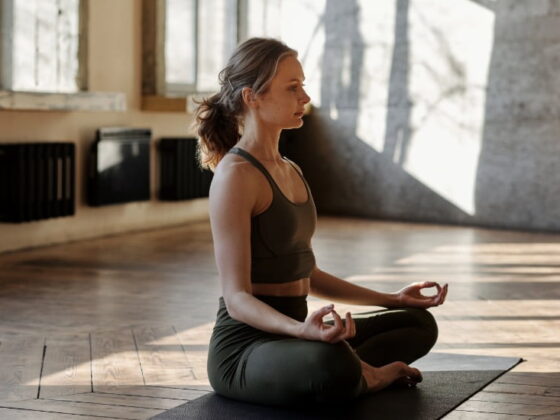Yoga is a transformative practice that nurtures the mind, body, and spirit. But beyond the physical postures lies another profound facet of this ancient tradition – guided meditation.
If you’ve ever found serenity in a meditative state, you might be inspired to share this gift with others. I know I was. Leading a guided meditation is an incredibly fulfilling and soul-nourishing experience, and in this blog post, I’ll help you uncover the key components that will allow you to successfully facilitate a guided meditation.
How To Lead A Guided Meditation
1. Find Your Meditative Voice
Just like finding your voice as a Yoga teacher, discovering your meditative voice is key to guiding others through this inward journey. It took me quite some time before I realised that being a good meditation teacher requires only one thing – authenticity (also doing a course doesn’t hurt). You can listen to thousands of guided meditations and dissect them to understand what makes them good or bad, but at the end of the day, it’s not about sounding like anyone else.
Embrace the essence of who you are and let it shine through your words. There are typically 2 routes that you can take – the first being gentle and soothing, and the second being empowering and motivational. Your voice is a reflection of your personality and should feel natural to you. Remember, authenticity is magnetic, and when you’re genuine in your approach, people will naturally connect with your guidance.
2. Set the Intention
Before embarking on any meditation, it’s essential to set a clear intention. Ask yourself what you hope to achieve through this meditation and what you wish to offer your participants. Whether it’s cultivating a sense of gratitude, finding inner balance, or releasing stress, the intention will serve as the foundation for your guided meditation. Make sure to communicate the intention of your guided meditation with those that participate in your class. They need to understand where you’re taking them and what they’ll be uncovering during your session.

3. Create a Calm Atmosphere
The environment plays a significant role in setting the tone for a successful guided meditation. Choose a tranquil and comfortable space with minimal distractions. Soft lighting, soothing music, or the gentle sound of nature can enhance the meditative experience.
I make sure to start preparing the space at least 1 hour beforehand. I take my time to light some incense or candles, place blankets and pillows in areas where they can comfortably be reached, and to choose the right sound to pair with my guidance.
I have a cup of warm tea at hand, to ensure that my throat doesn’t get dry, and I do a short 10 minute personal meditation to get into the right state and frame of mind. However you decide to prepare for your class, make sure that it resonates with you and gives you the feeling you want to share with your students.
4. Mindful Breathwork
The breath is an integral part of meditation. I always begin my guided meditation classes with some form of breathwork. It helps to centre everyone and to calm the mind. Encourage your students to take a few moments to focus on their breath, inhaling deeply and exhaling slowly.
During the meditation, periodically remind your students to return to their breath if their minds start to wander. The breath acts as a reliable anchor, helping to calm the fluctuations of the mind and promoting a state of centeredness. There have been many times where I forgot what I wanted to say during the meditation. In those moments, I simply take a breath and tell my students to do the same. Breathing is your meditation bestie!
5. Visualization and Imagery
Guided meditation often incorporates visualization and imagery to guide students on an inner journey. Paint vivid pictures with your words, leading them to beautiful landscapes, peaceful gardens, or sacred spaces within. Encourage them to engage their senses – feel the warmth of the sun, smell the fragrant flowers, and hear the gentle rustle of leaves.
As you weave this tapestry of imagery, give your students the freedom to explore and experience the meditation in their unique way. Avoid imposing rigid visuals; instead, offer gentle suggestions, allowing them to personalize their meditation.
Some of my favourite ways to start visualisation is by asking my students to visualise their happy place – a place that is very familiar to them. This allows them to relate to a personal experience that brings them peace and joy – which they can then tap into for the duration of the class.
6. Embrace Silence
Don’t try to fill the class with words. I’ve learned the hard way that silence is a powerful tool in guided meditation. By allowing moments of stillness between your words, you give your students space to immerse themselves in their inner realm.
Silence provides an opportunity for introspection and self-discovery. For me, there is nothing more annoying than a person who doesn’t stop talking while I’m trying to go into me zen-cave. Give your students space – they’re not there to consistently listen to you talking. When leading a guided meditation, you don’t need to fill every second with words. Embrace the power of silence and trust that your students will find meaning and depth in those quiet moments.

7. Lead with Compassion
As you guide others through their meditation, remember that each individual’s experience is unique. Embrace compassion and non-judgment, recognizing that emotions and sensations may vary among students.
Some students might start laughing, crying, or even screaming. Understand that they are not in control of what is being revealed to them, and as their guide, you have a responsibility to hold a safe space for them. On the other hand, you might really want your students to have immense emotional breakthroughs and yet, nothing happens.
Avoid becoming attached to specific outcomes or seeking validation for your guidance. Instead, simply be present for your students – holding a space of empathy and understanding, while embracing whatever does or does not come up.
8. Keep Your Meditation Centred Around Gratitude
My favourite quote is, “A grateful heart is a magnet for miracles.” I always begin and end my classes with a gratitude practice, while weaving gratitude throughout the class. Simply ask students to think of something, someone, or a moment that they’re incredibly grateful for. And at the end, make sure to give them some time to thank themselves for showing up.
Facilitating a guided meditation is an incredible opportunity to allow others to open their hearts to what is good in their lives, while shifting their attention away from everything that they would rather not deal with. As humans, we can often get caught up in looking at the glass half empty. Make sure that you use this opportunity to help your students cultivate a better attitude toward their life, themselves, and their loved ones.

9. Remove All Distractions
This probably should’ve been at the beginning, but hey – better late than never. Make sure that your cell phone, as well as those of your students are switched off and in your bag. Anything that could potentially make noise or distract your students from being present should be removed. Ask your students to go to the bathroom before the class begins.
Make sure there are no animals or kids that could potentially disrupt the class. And ensure that you walk softly and silently if you’re planning to move amongst your students.
Takeaway
Guiding a meditation is a beautiful and rewarding experience that allows you to share the gift of mindfulness and self-discovery with others. Embrace your authentic voice, set a clear intention, create a calming atmosphere, while incorporating visualization and imagery to lead your students on an inward journey.
Remember to offer moments of silence, practice compassion, and conclude with gratitude. And of course – remove any and all distractions! As you step into your role as a meditation guide, you’ll witness the transformative power of meditation and its profound impact on the lives of those you lead. So go forth and embrace your inner yogi as you guide others towards serenity and self-awareness. Namaste.

Frequently Asked Questions
Whats the Difference Between Guiding Meditations & Teaching Meditation
Guided meditation and teaching meditation may seem similar at first glance, but there are some subtle differences. Teaching meditation focuses on providing general instruction on how to meditate, whereas guiding meditation involves a facilitator directing individuals through a specific meditation practice.
Though many people use the concepts interchangeably, and need not be so distinct.
Group meditation broadens our understanding of how we can share space
Participating in group meditation allows us to experience an enhanced sense of connectedness through a shared collective experience. This connection can help to keep us motivated to continue with the practie. By cultivating a shared space where participants can explore their inner thoughts and emotions, we broaden our capacity in our ability to coexist and support one another in their process.
In addition to fostering a sense of community and support, group meditation can help us challenge traditional Western perspectives of social gatherings. As we learn to share space we open ourselves up to new ways of being together and deepening our connections with others.
What is group meditation like?
Group meditation blends the individual’s inward journey with a collective, shared experience. Each participant is actively engaged in their own meditation practice while simultaneously uniting with others to reach a common goal. In a typical group meditation session, participants may engage in sitting meditation, sharing time, chanting, walking meditation, or even partaking in a meal together in mindfulness. Group meditations can be a powerful way to enhance one’s practice and foster a sense of community.
The sharing period in a group meditation session is particularly powerful, as it allows participants to listen attentively to one another and become more aware of their own feelings. The confidential atmosphere of the group creates a safe and supportive space, enabling individuals to share authentically from their own lives and emotions, while also being nurtured in the process.
Meditating Together Online
The rise of online meditation groups has made it easier than ever to practice together, even when physically apart. Participating in group meditation online can assist in developing helpful habits, as well as in connecting with others in a shared intimate space. Many people have even taken that a step farther and created their own little zen business.
As the world continues to adapt to the challenges brought on by the COVID-19 pandemic, many meditation circles have transitioned to an online format, enabling individuals to maintain their practice and stay connected with their communities. By embracing this new way of meditating together, we can continue to create a supportive environment and challenge our assumptions about what it means to share space.
Meditation Practice Script
If you are stuck and have no idea where to begin, I put together a short guided meditation script that you can use to get an idea of what you can say. There are also some more here.
10 Minute Mindfulness Meditation Script
“Let’s begin our journey by finding a position that feels right to you. You might choose to sit or lie down, whatever allows you to be both relaxed and alert.
(Pause)
Now, gently close your eyes or, if you’re more comfortable with them open, lower your gaze. Take a moment to be aware of your body, feeling its weight and presence.
(Short pause)
Invite your attention to your breath. Notice the inhale, filling your lungs… and the exhale, gently leaving your body… Let’s do that a few more times, just observing the breath in… and the breath out…
(Longer pause)
As thoughts come and go, remember it’s all part of the process. There’s no need to engage with the content of the thoughts. Simply acknowledge them and kindly bring your attention back to the breath.
(Pause for breath awareness)
Now, shift your awareness from your breath to the sensations in your body. Notice the feeling of the ground beneath you, the texture of the clothes on your skin, the temperature of the room. Be curious about each sensation as it arises, not trying to change it, just observing it.
(Pause for body awareness)
Now, let’s gently shift our awareness to the sounds around us. Without searching for sounds, let them come to you. The distant noises, the close ones, even the silence between them. Just noticing them without judgment or preference.
(Pause for sound awareness)
Shift our attention to our thoughts and feelings. See if you can observe them as if they were clouds passing in the sky. Again, there’s no need to engage with their content. Simply note them and let them float by.
(Pause for thought and emotion awareness)
Now, gently bring your focus back to your breath. Noticing again the inhale… and the exhale…
(Pause for breath awareness)
As end this session, start to deepen your breath, gently wiggling your fingers and toes. Take your time and, when you’re ready, allow your eyes to blink open, bringing your awareness back to the room.
(Pause)
Thank you for sharing this mindful journey with me. Remember that mindfulness can be practiced at any moment, wherever you are. May you carry this awareness throughout the rest of your day.”



